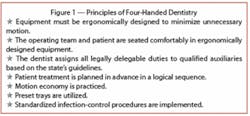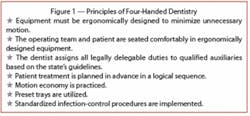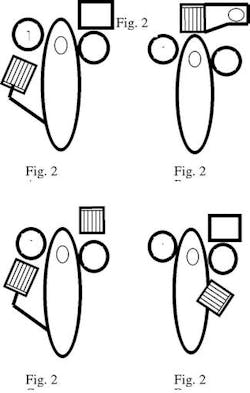Are you ready to switch to four-handed dentistry?
If someone told you that you could increase productivity with decreased stress and strain and that the patient and dental team would be happier, wouldn’t you ask, “What do I do?” The answer to this question is not new; it’s been around for nearly 50 years. Yet, the most current generation of dentists knows little about the concept known as four-handed dentistry.
Today, this concept’s formula for success includes the application of ergonomics - the study of the physical relationship between people and their environment. Four-handed dentistry is the process where a skilled operator and assistant work together to perform clinical tasks in a safe, stress-free environment.
Any dental professional will tell you that sitting at chairside all day is very uncomfortable and may result in lower back pain, tendonitis, and/or neuromuscular or musculoskeletal complications. This article is written for team members who are faced with undue stress due to poorly designed facilities, and it offers suggestions for all team members that will make a definitive difference in your work strategies.
Basic tenets of four-handed dentistry
Many dentists and assistants claim they practice four-handed dentistry, yet still suffer the results of physical stress due to the use of inappropriate equipment and techniques that fall short of meeting the basic tenets of four-handed dentistry. Dentists can still be observed changing their own burs, twisting and turning to reach equipment on their sides of the chair. If the assistant is not in charge of all instrument transfers and the equipment is not within his or her reach, true four-handed dentistry is not being practiced.
Four-handed dentistry is not “hurry-up dentistry.” It is based on a set of principles that define the conditions under which efficiency can be attained. These principles are shown in figure 1.
null
Equipment selection
Selection of equipment for use in four-handed dentistry is integral to its success. Over the years, many manufacturers have attempted to meet the criteria and failed. Some of the original research done at the University of Alabama School of Dentistry during the evolution of four-handed dentistry resulted in equipment now being manufactured by Health Science Products, Inc. (HSP) still the most sound in meeting these criteria.
The team cannot successfully practice four-handed dentistry if members must reach for instrumentation, become entangled in an array of cords, or are unable to comfortably reach the patient. You need only walk onto a convention floor to see a myriad of equipment that causes the dental team to become confused and this equipment can result in undue stress when used.
The basic dental unit designs available today include the side delivery, rear delivery, split unit/cart, and transthorax (see Figures 2A, 2B, 2C, and 2D). An often-overlooked factor when choosing a dental unit is that the assistant should be the primary focus.
Before purchasing equipment, the dentist and team members must realize this is a long-term investment that must ensure good ergonomics and safe practice. Asking the following questions when selecting equipment will lead you toward the first steps in creating an ergonomically sound practice. If the answer is “no” to any of these factors, the search for equipment should continue.
Patient chair
*Does it have a thin, narrow back with a concave seat and lower lumbar support?
*Is it free of wide wings that prohibit the assistant and operator from being seated close to the patient?
*Does it provide an automatic preset positioner that places the patient in supine position?
*Is it free of protrusive devices on the back?
*Does it provide neck and head support for the patient?
*Is it capable of being positioned for right- or left-handed operators?
*Is it easily cleanable and free of fabric upholstery?
Dental unit
*Is it a transthorax style?
*Does it adjust vertically and have a horizontal tilt for easy access to operator and assistant?
*Does it have smooth tubing that is tangle-free, off the floor, and gravity retractable?
*Is it able to withstand rigorous daily use?
*Is it designed to contain multiple handpieces and high-technology devices?
*Is it free of a bracket table and cuspidor?
Dental stools
*Do they provide a stable base with four or five casters?
*Do they have well-padded flat or contoured seats?
*Are they easily adjustable?
*Does the assistant’s stool provide back and abdominal support that adjusts vertically and horizontally?
*Does the operator’s stool provide vertical and horizontal adjustment with back support?
Mobile cabinet
*Is it stable and easy to move?
*Does it provide easy access to instruments and materials?
*Is there adequate work surface within 1-2 inches of the elbow?
*Does it provide a movable work surface that can be positioned over the assistant’s lap?
*Does it provide adequate storage with a deep well at the top?
Fixed cabinetry
*Can it be kept to a minimum?
*Can it be positioned to provide for maximum floor space?
*Can it be positioned so the assistant can gain access to backup materials as needed?
*Is a section of it located far enough away to avoid infectious aerosols coming in contact with records and radiographs?
Dental unit components, including air/water syringe, handpieces, and HVE system
*Do each of these components contain lightweight, smooth, flexible hosing?
*Are they easy to use?
*Are there fiberoptic options?
*Can they be easily positioned so that the assistant can readily pass them to the operator without infringing on the patient?
*Are the attachments to the hoses sterilizable?
*Do the handpieces provide a range of speeds and locking mechanisms for hoses to prevent tugback?
*Does the air/water syringe retain an angled tip that is easily rotated?
Evaluating equipment designs
Figure 2 contains schematic examples of the four common unit styles. Applying these criteria to several popular designs may help you determine that you need to modify your clinical facility.
Side delivery (Figure 2A)
This unit has been a popular concept for many decades. In fact, most schools use this style of unit, often supplied with a bracket tray. This unit requires the dentist to pick up the handpieces, which forces him or her to remove his or her eyes from the treatment site, twist and turn to grasp the instrument, and then refocus. This results in stress and fatigue. The assistant can’t reach the instruments to exchange handpieces or change burs, which reduces productivity. Often in this set-up, high-velocity evacuation is located on the assistant’s side of the chair that pushes the assistant away from the chair. At times, HVE hoses are located on the mobile cart. The concern here should be whether the addition of the hoses to this cart has diminished its effectiveness. Does it still have a mobile top and adequate storage that is not impeded by the hoses?
Rear delivery (Figure 2B)
The doctor must pick up the handpieces, which requires severe twisting and turning, as well as eye strain, since the doctor is forced to turn from the operating field to pick up the handpiece. Often it is necessary to transfer the handpiece from the retrieval hand to the operating hand. The units are mounted in a fixed position that cannot be moved to accommodate for the positions of the dentist or for ease of use for the assistant. HVE hosing and air/water syringes are permanently affixed to an assistant’s work area. Since it is in the rear, it requires that the assistant lean forward. When a mobile cart is used with this concept, it may interfere with access to the sink or to the HVE and air/water syringe. For the assistant, this can provide undue stress and strain and limit access for increased productivity.
Split unit/cart (Figure 2C)
This concept places part of the dental unit on the operator’s side and the HVE and air/water syringe on the assistant’s mobile cabinet. As in the side delivery unit, it requires the dentist to grasp the handpieces and makes them inaccessible to the assistant, thus reducing productivity. The assistant can only use the HVE and the air/water syringe that are attached to the mobile cabinet and is unable to transfer handpieces or change burs. Often mobile cabinets used in this concept are not designed to contain back-up instruments and adequate storage for materials. The split unit design can limit the assistant’s working space and requires that back-up instruments be placed in tubs on the fixed cabinetry. This position requires additional motion to retrieve needed instruments and materials and opens the door to cross-contamination of instruments stored in the tubs.
Transthorax unit (Figure 2D)
This unit design meets the requirements of time and motion concepts and promotes good ergonomic positioning. With the unit over the patient’s thoracic area, the assistant can easily retrieve the handpieces and transfer them to the doctor who does not need to remove his or her eyes from the operating site. The Alabama Mobile Cabinet with a front-to-back moveable top that comes over the assistant’s knees acts as the major supply cabinet, housing all of the instruments within a Class III reach. There are no hoses to interfere with the assistant’s position. This type of unit has been designed for the practice of true four-handed dentistry. HSP manufactures the only transthorax unit available.
Conclusion
Four-handed dentistry is simply the only way to practice dentistry today. Four-handed dentistry is more than just four hands being used. True four-handed dentistry requires that appropriate techniques be followed for seating the patient and operating team, instrument transfer, oral evacuation, infection control, and that, during all of these procedures, concern be given to conserving motion. It also requires that the selection of equipment be based on the assistant’s domain and good ergonomic practice. The dental profession cannot continue to work with equipment designed without concern for productivity and stress-reduction. The assistant and dentist must work as a team, in practice as well as in the design of a safe, ergonomically sound working environment.
For the past 35 years, Betty Ladley Finkbeiner has been chair of the dental assisting program at Washtenaw Community College in Ann Arbor, Mich. During this time, she has coauthored several textbooks, scripts, and videotapes. She has served on the Michigan Board of Dentistry and most recently has gained recognition for the creation of an online curriculum for on- the-job trained dental assistants as well as traditional students to obtain recognized credentials via the Internet. To contact her, call (734) 973.3332 or e-mail her at [email protected].


